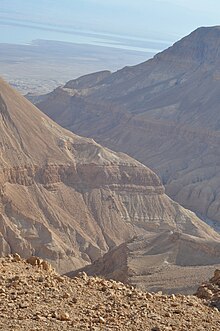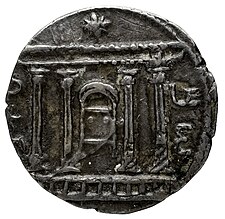
 |
| Part of a series on the |
| Bar Kokhba revolt |
|---|
The Bar Kokhba refuge caves are natural caves used for shelter by Jewish refugees during the later phases of the Bar Kokhba revolt. Most of the refuge caves were located in the Judaean Desert, nestled within steep cliffs far away from settlements, many overlooking the Dead Sea and the Jordan Valley. Some were also found in ravines flowing into the Dead Sea, while others were nestled within the Judaean Mountains.[1] Unlike the other two hideout systems used by the rebels, the man-made rock-cut hiding complexes, and the hard-to-reach cliff shelters which often contain hewn installations, the refuge caves remained largely untouched by human intervention.[1][2]
Jews taking shelter in refuge caves aimed to escape the Roman army during its suppression of the revolt.[1] These caves are thought to have offered sanctuary to those in the eastern Judaean Mountains and the Jordan Valley.[3] Some caves show signs of successful refuge, while others contain skeletal remains of adults and children, indicating deaths due to starvation, thirst, or encounters with Roman forces, as evidenced by the construction of siege camps and the discovery of arrowheads embedded in cave ceilings.[1]
Refuge caves such as the Cave of Letters and Cave of Horror in Nahal Hever, as well as those within Wadi Murabba'at, have yielded many notable archaeological artifacts. These include fragments of Biblical scrolls, documents inscribed in Aramaic and Greek, a variety of weaponry—both locally produced and plundered from the Romans—and coins minted by the Bar Kokhba administration. Moreover, these caves have served as time capsules, preserving artifacts of daily life such as metalwork, pottery, glassware, jewelry, textiles, and sandals. These remnants provide insights into life during this period and the experiences of the refugees.[1][4] Among the finds are letters authored by Simon bar Kokhba himself, offering a direct glimpse into the leadership and administration of the revolt.[5]
- ^ a b c d e Eshel, Hanan; Zissu, Boaz (2019). "The Refuge Caves". The Bar Kokhba Revolt: The Archaeological Evidence. Jerusalem: Yad Izhak Ben-Zvi. pp. 62–64. ISBN 978-965-217-429-1.
- ^ Shivtiel, Yinon; Osband, Mechael (2018). "The Meiron Valley Cave Survey and the Use of Karstic Caves for Refuge in the Roman Period" (PDF). In the Highland's Depth. 8. Ariel University Press: 27–55. doi:10.26351/ITHD/8/14. ISSN 2308-247X. Retrieved 3 May 2024.
- ^ קלונר, עמוס; זיסו, בועז (2005). "מערכות המסתור בארץ יהודה: עדכון ארכיאולוגי וגיאוגרפי של השתרעות מלחמת בר כוכבא". In מור, מנחם; פסטור, ג'ק; רונן, ישראל; אשכנזי, יעקב (eds.). לאוריאל: קובץ מחקרים בתולדות ישראל בעת העתיקה (in Hebrew). ירושלים: מרכז זלמן שזר לתולדות ישראל. p. 125. ISBN 965-227-210-8.
- ^ Zissu, Boaz; Eshel, Hanan (2016-01-01), "Religious Aspects of the Bar Kokhba Revolt: The Founding of Aelia Capitolina on the Ruins of Jerusalem", The Religious Aspects of War in the Ancient Near East, Greece, and Rome, Brill, p. 389, ISBN 978-90-04-32476-3, retrieved 2024-05-02
- ^ Cite error: The named reference
:3was invoked but never defined (see the help page).
© MMXXIII Rich X Search. We shall prevail. All rights reserved. Rich X Search
